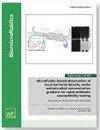研究神经毒素从肠道到大脑转运的体外多器官微观生理学系统(MPS)
IF 2.4
4区 工程技术
Q2 BIOCHEMICAL RESEARCH METHODS
引用次数: 0
摘要
大脑底部黑质中产生多巴胺的神经元死亡是帕金森病(PD)发病过程中的一个决定性病理特征。然而,帕金森病是一种多系统疾病,也会影响周围神经系统和胃肠道(GIT),并通过肠-脑轴(GBA)相互作用。我们对胃肠道-大脑双流微观生理学系统(MPS)进行了改良,以研究诱发帕金森病的神经毒素--1-甲基-4-苯基吡啶鎓(MPP+)从肠道到大脑的转运及其对关键胃肠道细胞和脑细胞的影响。模块化胃肠道-脑 MPS 与定量和形态计量图像分析方法相结合,再现了细胞特异性神经毒素诱导的多巴胺能细胞毒性和线粒体毒性,而药物对胃肠道源性结肠上皮细胞的活力或细胞膜的完整性没有不利影响。我们的研究结果证明了胃食管-脑 MPS 在测量神经元反应方面的实用性和能力,以及它在鉴定胃食管中产生的可加剧或防止神经元炎症和细胞死亡的化合物或分子方面的适用性。本文章由计算机程序翻译,如有差异,请以英文原文为准。
An in vitro multi-organ microphysiological system (MPS) to investigate the gut-to-brain translocation of neurotoxins
The death of dopamine-producing neurons in the substantia nigra in the base of the brain is a defining pathological feature in the development of Parkinson's disease (PD). PD is, however, a multi-systemic disease, also affecting the peripheral nervous system and gastrointestinal tract (GIT) that interact via the gut–brain axis (GBA). Our dual-flow GIT–brain microphysiological system (MPS) was modified to investigate the gut-to-brain translocation of the neurotoxin trigger of PD, 1-methyl-4-phenylpyridinium (MPP+), and its impact on key GIT and brain cells that contribute to the GBA. The modular GIT–brain MPS in combination with quantitative and morphometric image analysis methods reproduces cell specific neurotoxin-induced dopaminergic cytotoxicity and mitochondria-toxicity with the drug having no detrimental impact on the viability or integrity of cellular membranes of GIT-derived colonic epithelial cells. Our findings demonstrate the utility and capability of the GIT-brain MPS for measuring neuronal responses and its suitability for identifying compounds or molecules produced in the GIT that can exacerbate or protect against neuronal inflammation and cell death.
求助全文
通过发布文献求助,成功后即可免费获取论文全文。
去求助
来源期刊

Biomicrofluidics
生物-纳米科技
CiteScore
5.80
自引率
3.10%
发文量
68
审稿时长
1.3 months
期刊介绍:
Biomicrofluidics (BMF) is an online-only journal published by AIP Publishing to rapidly disseminate research in fundamental physicochemical mechanisms associated with microfluidic and nanofluidic phenomena. BMF also publishes research in unique microfluidic and nanofluidic techniques for diagnostic, medical, biological, pharmaceutical, environmental, and chemical applications.
BMF offers quick publication, multimedia capability, and worldwide circulation among academic, national, and industrial laboratories. With a primary focus on high-quality original research articles, BMF also organizes special sections that help explain and define specific challenges unique to the interdisciplinary field of biomicrofluidics.
Microfluidic and nanofluidic actuation (electrokinetics, acoustofluidics, optofluidics, capillary)
Liquid Biopsy (microRNA profiling, circulating tumor cell isolation, exosome isolation, circulating tumor DNA quantification)
Cell sorting, manipulation, and transfection (di/electrophoresis, magnetic beads, optical traps, electroporation)
Molecular Separation and Concentration (isotachophoresis, concentration polarization, di/electrophoresis, magnetic beads, nanoparticles)
Cell culture and analysis(single cell assays, stimuli response, stem cell transfection)
Genomic and proteomic analysis (rapid gene sequencing, DNA/protein/carbohydrate arrays)
Biosensors (immuno-assay, nucleic acid fluorescent assay, colorimetric assay, enzyme amplification, plasmonic and Raman nano-reporter, molecular beacon, FRET, aptamer, nanopore, optical fibers)
Biophysical transport and characterization (DNA, single protein, ion channel and membrane dynamics, cell motility and communication mechanisms, electrophysiology, patch clamping). Etc...
 求助内容:
求助内容: 应助结果提醒方式:
应助结果提醒方式:


